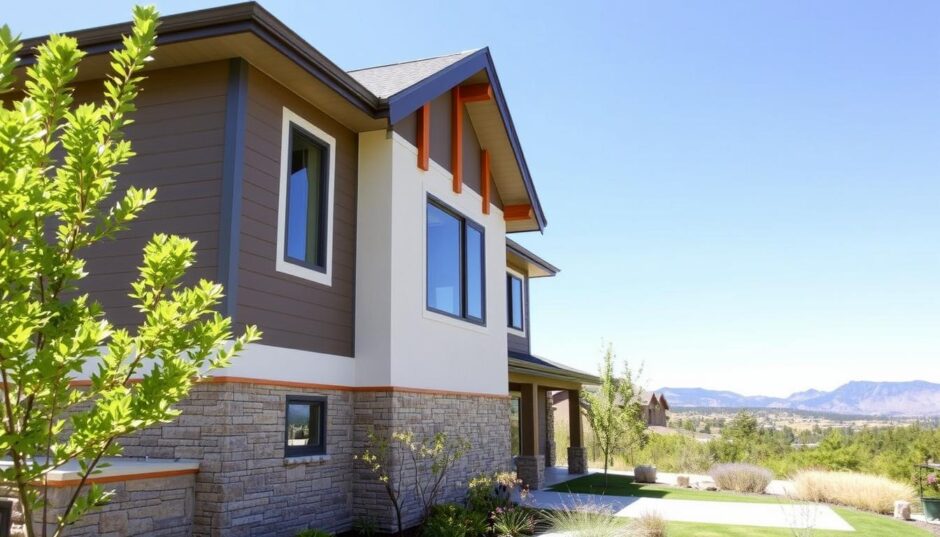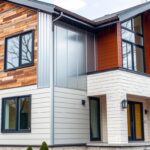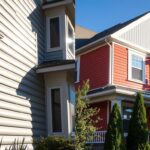What Siding is the Most Fire Resistant?
Wildfires are a growing concern, especially in places like California. After a long drought, protecting homes from fires is more important than ever. Fire resistant siding is key to keeping homes safe. It’s especially crucial in California, the most wildfire-prone state.
Materials like fiber cement siding offer strong protection against wildfires. It doesn’t burn easily and keeps its color well. Unlike wood siding, which is very flammable, and vinyl siding that melts at a distance, fiber cement is a safer choice.
There are many fire-resistant siding options available. Steel and aluminum siding can handle harsh weather and don’t catch fire easily. Brick and stone veneers are also good, but they must be installed correctly to work well. The right siding can save homes from fires and keep people safe.
Key Takeaways
- Fire resistant siding is essential for home protection, especially in wildfire-prone areas.
- Fiber cement siding is a popular choice for fire resistant siding due to its non-combustible and naturally flame-retardant properties.
- Steel and aluminum siding can withstand extreme weather conditions and do not ignite easily.
- Brick and stone veneers are highly fire-resistant, but require proper installation to prevent fire penetration.
- Choosing the right fire resistant siding materials can significantly reduce the risk of damage from wildfires.
- Fire resistant siding can help prevent the rapid spread of flames from home to home, potentially saving lives in wildfires.
- Homeowners should consider factors like maintenance, durability, and cost when selecting fire resistant siding options.
Understanding the Importance of Fire Resistant Siding
Fire safety is crucial in home building. Fire-resistant siding is key to keeping homes safe. Building codes and fire safety rules help ensure homes have this siding. Fire ratings, like Class A, show how well siding can resist fire.
Using fire-resistant siding can protect homes and make them look better. With wildfires and other fires, it’s vital to pick siding that can handle high heat.
Why Fire Resistance Matters in Home Construction
Fire-resistant siding adds extra protection against wildfires and other fires. It can stop fire from spreading and reduce damage to homes. Popular choices include fiber cement, steel, and brick.
Building Codes and Fire Safety Requirements
Building codes and fire safety rules differ by area. But most require fire-resistant siding. Homeowners should check local rules. Fire ratings, like Class A, show how well siding resists fire.
Fire Ratings Explained
Fire ratings measure how well siding can resist fire. Class A is the best, meaning it can handle high heat and stop fire spread. Lower ratings, like Class B and Class C, mean less fire resistance. Choosing siding with high ratings is important for home safety.
Top Fire Resistant Siding Materials for Maximum Protection
Choosing the right siding material is key to protecting your home from fires. Materials like fiber cement, metal, brick, and stucco are top choices. They offer strong protection against wildfires and other fire dangers.
These options create a barrier that can stop fires from spreading. This helps keep your home safe from damage.
Some of the top fire resistant siding materials include:
- Fiber cement siding, which is durable and resistant to flames
- Metal siding, which is non-combustible and provides excellent fire protection
- Brick, which is a natural fire-resistant material that can withstand high temperatures
- Stucco, which is a durable and fire-resistant material that can provide long-lasting protection
These materials offer maximum protection for your home. They give you peace of mind and ensure your safety. By picking the right siding, you can safeguard your home and family from fire risks.
These siding options also have other benefits. They are durable and require little maintenance. Investing in fire resistant siding protects your home and investment. It also boosts your property’s value.
| Siding Material | Fire Resistance | Durability |
|---|---|---|
| Fiber Cement Siding | Class A fire rating | Resistant to moisture and rot |
| Metal Siding | Non-combustible | Resistant to high winds and hail |
| Brick | Natural fire resistance | Long-lasting and durable |
| Stucco | Fire-resistant | Resistant to cracking and fading |
Fiber Cement Siding: The Industry Leader in Fire Resistance
Fiber cement siding is a top pick for homeowners because it’s fire-resistant and lasts long. James Hardie, a leading maker, offers top-notch products. These products have a Class A fire rating, meeting ASTM E84 standards.
This siding doesn’t burn easily and won’t warp, rot, or crack. It’s a solid choice for those who want a durable home exterior. Key benefits include:
- Non-combustible material
- Class A fire rating
- Resistant to warping, rotting, and cracking
- Low maintenance requirements
James Hardie backs its siding with a 30-year warranty. This gives homeowners confidence in their choice. Fiber cement siding is a smart pick for fire safety and durability.
In wildfire-prone areas, fiber cement siding is a vital defense. It keeps homes safe from fires. Its fire-resistant and durable nature makes it a top choice for fire safety.
| Feature | Description |
|---|---|
| Fire Rating | Class A fire rating achieved through testing in accordance with ASTM E84 standards |
| Flame Spread Index | 0, indicating it is non-combustible and does not contribute to flame spread |
| Durability | Resistant to warping, rotting, and cracking |
Metal Siding Options and Their Fire-Resistant Properties
Metal siding is a top pick for homes because it’s durability and fire-resistant. It’s made from materials like aluminum or steel. This makes it non-combustible and eligible for a Class A rating. This means it can handle severe fires for a long time.
Metal siding has many perks. It can reflect sunlight, which might cut down cooling costs. It’s also very energy efficient. Plus, metal roofs can last up to 50 years, beating out asphalt shingles. And, it only needs soap and water for upkeep, making it easy to maintain.
Brands like Kingspan offer high-quality metal siding. It looks great and is fire-resistant. For the best results, get it installed by pros. Regular checks and upkeep are key to keep it in top shape.
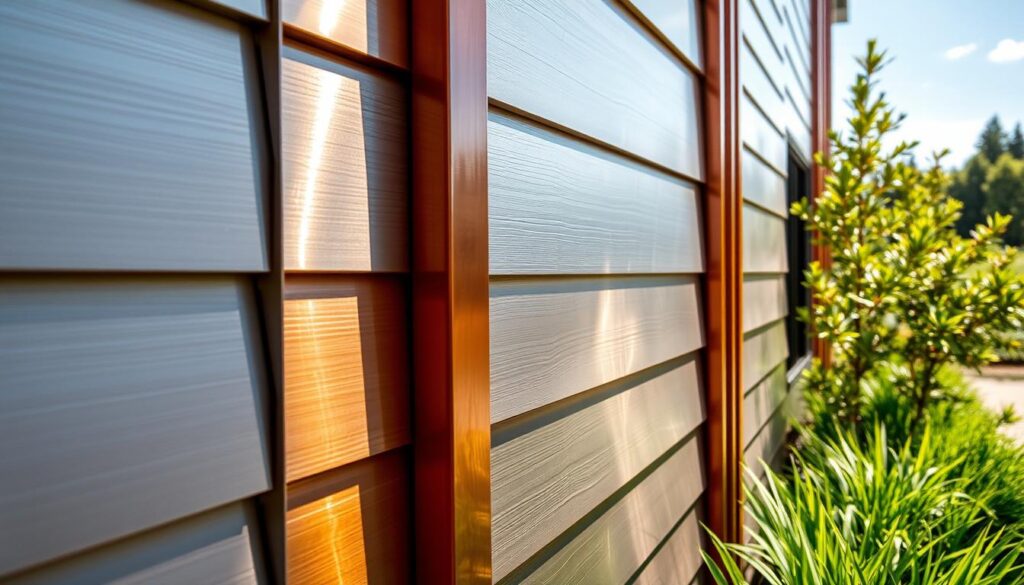
In summary, metal siding is a solid choice for those wanting something durable and fire-safe. Its many benefits and easy care make it a favorite among homeowners.
Brick and Stone Veneer: Natural Fire Protection
Brick and stone veneer are top picks for natural fire protection. They are naturally flame-resistant. This is because they don’t have caulked joints, which fire can’t get through.
These materials offer a natural fire protection layer. This makes them a favorite among homeowners.
Compared to other siding options, brick and stone veneer stand out. Brick can handle high temperatures because it’s non-combustible. Stone veneer also resists fire and heat well.
Statistical data shows that brick and stone are among the most fire-resistant. They have a Class A fire resistance rating.
- Class A fire resistance rating
- Naturally flame-retardant materials
- No caulked joints to prevent fire penetration
- Durable and long-lasting
In summary, brick and stone veneer are great for natural fire protection. They are durable and protect homes from fire damage.
Stucco as a Fire Resistant Siding Choice
Stucco is a top pick for fire-resistant siding because it’s durability and can handle high heat. It has a fire rating of 1 hour, making it great against wildfires and other fire dangers. It’s more fire-safe than wood and manufactured wood, which burn easily and don’t protect against fire.
Stucco has many benefits as a fire-resistant siding option:
- It’s a non-combustible material that can stand flames for 60 minutes.
- It doesn’t melt or burn at high temperatures.
- It can be used on stick-built homes or to cover stone or brick for looks.
While stucco is attractive, it’s important to watch for cracks. Cracks can weaken its fire resistance. But, with the right installation and care, stucco can last long and protect against fires. It’s also a budget-friendly choice that can make a home safer and more valuable.
In places with environmental dangers, extra layers can be added to stucco for more fire safety. Solid brick and stone offer even more protection than stucco. Yet, stucco is still a favorite because of its fire-resistant and durability qualities. With the right setup and upkeep, stucco can keep a home safe from fires and boost its value.
| Material | Fire Rating | Durability |
|---|---|---|
| Stucco | 1 hour | High |
| Brick | 2 hours | Very High |
| Stone | 2 hours | Very High |
Comparing Costs of Fire Resistant Siding Options
Fire-resistant siding costs can change a lot based on the material. Homeowners need to think about the upfront cost, long-term upkeep, and insurance perks. For example, fiber cement siding can save money, costing about 2% less than a standard home.
Popular choices include steel, brick, and stucco. Prices range from $1 to $35 per square foot, based on type and quality. Some materials can last up to 100 years or more. Here’s a table comparing costs and lifespans:
| Material | Cost per Square Foot | Lifespan |
|---|---|---|
| Steel Siding | $1 to $35 | 15 to 100+ years |
| Brick Siding | $10 to $30 | 50 to 100+ years |
| Stucco Siding | $3 to $22 | 20 to 50 years |
| Fiber Cement Siding | $5 to $18 | 50 years |
Even though fire-resistant siding might cost more upfront, the long-term savings and insurance perks are worth it. Homeowners might get insurance discounts, which can lower the initial cost.
Maintenance Requirements for Fire Resistant Siding
Regular maintenance is key to keeping fire-resistant siding in top shape. This means cleaning and checking it often to catch problems early. For instance, fiber cement siding needs cleaning to get rid of dirt and debris.
Some important maintenance tasks for fire-resistant siding include:
- Regularly cleaning the siding to remove dirt and debris
- Inspecting the siding for any signs of damage or wear
- Repairing or replacing damaged or worn-out siding components
By keeping up with maintenance, you can make your siding last longer and stay fire-resistant. Siding can last from 20 to 70 years, with some types lasting up to 100 years with the right care. 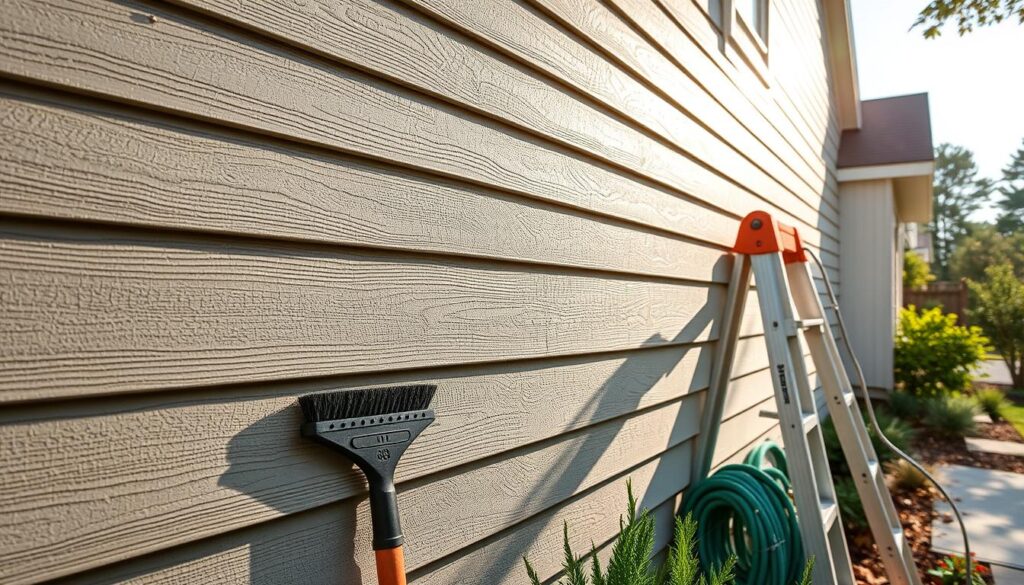
Also, keeping at least 5 feet of space around your home is vital to lower fire risk. By following these steps, homeowners can keep their siding safe and protected for years.
It’s also worth noting that fire-resistant gel coatings can handle temperatures up to 3,500 degrees Fahrenheit. But, they only work for 6 to 36 hours, depending on the weather. Regular maintenance and checks can spot where these coatings are needed, keeping your siding fire-safe.
Environmental Impact and Sustainability of Fire-Resistant Materials
Fire-resistant materials have a big impact on the environment. Their production can affect the planet in many ways, like using a lot of energy or creating waste. For example, fiber cement siding is made from natural stuff like cellulose fiber and sand. This makes it better for the planet.
Some materials, like metal siding, are really good because they can be recycled a lot. This means we don’t need to get new stuff from the earth as often. But, materials like vinyl siding are bad for the environment because they don’t break down and use a lot of energy to make. Sustainability is important because it helps the planet and makes the material last longer.
It’s important to know how different fire-resistant materials affect the environment. Here’s a table that shows how different materials stack up:
| Material | Environmental Impact | Sustainability |
|---|---|---|
| Fiber Cement Siding | Low carbon footprint, recyclable | Highly sustainable, made from natural resources |
| Metal Siding | High recycling rate, energy-intensive production | Sustainable, reduces need for new resource extraction |
| Vinyl Siding | High carbon footprint, non-biodegradable | Less sustainable, contributes to pollution and waste |
In short, the way fire-resistant materials affect the environment is very important. By picking materials like fiber cement and metal siding, we can help the planet. This makes our future cleaner and greener.
Insurance Benefits and Building Code Compliance
Homeowners can get big insurance benefits by putting fire-resistant siding on their homes. Many insurance companies give discounts to those who use fire-resistant materials. This is because these homes are less likely to get damaged by wildfires. Also, building code compliance is key to making sure homes are safe. Fire-resistant siding helps meet local building codes, which can lower insurance costs.
What affects insurance benefits and building code compliance includes the siding material, home location, and fire resistance level. For instance, homes in wildfire-prone areas need stricter building code compliance. This might mean using fire-resistant siding and ember-resistant vents.
To meet building code compliance and get the most insurance benefits, homeowners should:
- Choose fire-resistant siding materials like fiber cement or brick
- Install ember-resistant vents and screens
- Keep vegetation and debris away from the home
- Regularly check and maintain siding and vents
| Siding Material | Fire Resistance | Insurance Benefits |
|---|---|---|
| Fiber Cement | High | Yes |
| Brick | High | Yes |
| Vinyl | Low | No |
By picking the right fire-resistant siding and following local building code compliance rules, homeowners can get big insurance benefits. They’ll also have peace of mind knowing their home is safer from wildfires.
Conclusion: Making the Right Choice for Your Home’s Fire Protection
Choosing the right fire-resistant siding is crucial for protecting your home from fires. Materials like fiber cement, metal, brick, and stucco provide top-notch fire protection. They make your home safer from wildfires and other fire dangers.
In places at high risk of fires, like wildland-urban interfaces, fire-resistant siding is a must. Following local building codes ensures your home meets fire safety standards. This protects your family and your home’s value. The right siding can also save you money on insurance and increase your home’s resale value.



